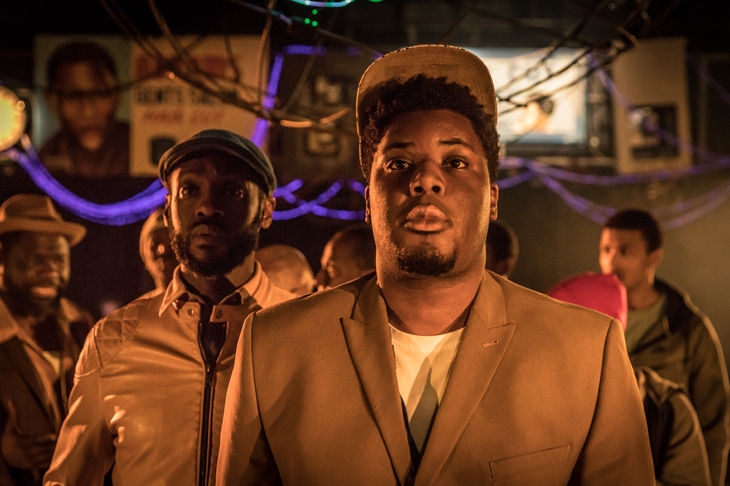The National Theatre could hardly resist Barber Shop Chronicles. The play shines a light on a disregarded ethnic community, black urban males, who like to hang around in barber salons seeking friendship, laughs and tittle-tattle. Setting the play in a single venue would just be a sitcom, like Desmond’s, so the show establishes a series of shops stretching from London to the capitals of various sub-Saharan nations. This makes it a global epic. In theory, at least. In fact, it’s still a sitcom with some melodramatic bits on the end. The disjoined structure is tiresome at first as the action keeps legging it from Britain to Nigeria and Ghana and back again.
Inevitably, the intellectual level is pretty undemanding, somewhere between music-hall and panto. The guys lounge around on chairs swapping jokes, telling old stories and haggling over politics. Some of the comments are amusing. On Africa’s disdain for punctuality: ‘Time cannot contain us!’ On black women’s obsession with wigs: ‘Why can our wives get away with murder? Because their DNA will be traced to a bald woman in India.’ There’s a great speech by an embittered South African who blames Mandela for his policy of reconciliation which left the black populace ‘emasculated’ and seething with unexpressed rage that manifests itself today in the ceaseless waves of violent crime.
The show’s big attraction is its party atmosphere. Before curtain-up, the cast jig around on stage or mingle with the audience. Afterwards, everyone is invited up for a disco. Director Bijan Sheibani has assembled some of the finest comic talents around. Hammed Animashaun is a superb vaudevillian and Sule Rimi delivers one of the best impersonations of affronted Nigerian masculinity you’ll ever see. The gameplan, presumably, is to draw black malesto the South Bank and to hope they’ll return for the classical repertoire. Maybe it’ll work.
Common by D.C. Moore is set in England in 1809 at the time of the enclosures. We meet Mary, a fortune-telling prostitute, who claims to be an aristocrat of French descent. She also identifies herself as a ‘thief’. The dialect of the play is contrived, antiquarian and vulgar. ‘If my language some offends, fist-fuck you all,’ says Mary, charmingly. In the opening scene she asks a peasant for directions to ‘the Cock Inn’, a name selected, rather optimistically, to get laughs. The peasant is helped by an automated raven that can talk. After this baffling overture the play lurches from one obscurity to another. There are arguments in taverns, stand-offs between uppity rustics and sneering toffs. A turnip-picker is murdered and his crimson entrails are yanked from within his Ribena-stained smock. Synchronised scythe-dances give way to troops of actors trudging across the stage carrying rucksacks containing leafless branches.
Mary’s character is impossible to pin down. She’s a swindler. She’s a visionary. She’s a lesbian. She’s a dispenser of sage advice. Suddenly she’s pregnant. She begs her girlfriend to emigrate with her to Massachusetts. She uses a tantric-sex dance to persuade a snooty toff to moderate the effects of land reforms. Later, she seduces his maid. The craziness multiplies. A Geordie gamekeeper murders a she-bumpkin dressed as a he-bumpkin. Two men rush on stage pretending to thump each other in the face. A pint of ketchup later, their fisticuffs are halted by an ooh-arr yokel with a Swindon accent. This is Mary’s lover, who is ardently propositioned by her own brother. She advises him to drop incest and take up revolution. A male figure appears with his beige penis frontally presented and urinates on the stage. (I thought this was an audience member but it turned out to be one of the cast.) Mary is lynched and buried alive by masked yokels but she later exhumes herself and has a chat with the automated raven.
I haven’t made these scenes up. A simple oversight lies behind this confusion. Where’s the trajectory? We never find out what the main character wants and why. D.C. Moore has ignored the mission-seeking blueprint that underlies every piece of drama ever written, from the Odyssey (man returns home) to the dead parrot sketch (man returns pet).
What an embarrassment for the National. Lots of baffled ticket-holders bailed out at the interval. The Olivier’s auditorium looked like an empurpled jaw following multiple extractions. Local schoolchildren may be recruited to fill the voids. An awful prospect. Youngsters forced to experience this bolus of drivel will probably shun the theatre for decades afterwards. The production highlights a key difference between subsidised and commercial art. Bad commercial art gets ignored and forgotten. Bad subsidised art enjoys a life-support system, also subsidised, that can lure the innocent into its toxic embrace. Please, National Theatre, spare the kids this one. It could take a generation to repair the damage.







Comments